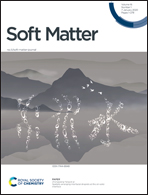Fabrication of novel MXene (Ti3C2)/polyacrylamide nanocomposite hydrogels with enhanced mechanical and drug release properties†
Abstract
A highly stretchable nanocomposite (NC) hydrogel was fabricated via in situ free radical polymerization of acrylamide. In particular, an exfoliated two-dimensional MXene (Ti3C2) nanosheet was utilized as a crosslinker instead of traditional organic crosslinkers. The exfoliated Ti3C2 nanosheets were confirmed by atomic force microscopy (AFM) and dynamic light scattering (DLS) measurements. Compared with traditional organic crosslinked N,N-methylene bisacrylamide (BIS)/polyacrylamide (PAM) hydrogels (fracture strength of 32.0 kPa and elongation of 109.6%), the synthesized Ti3C2/PAM NC hydrogels exhibited greatly improved mechanical properties with fracture strengths of 66.5 to 102.7 kPa, compressive strengths of 400.6 to 819.4 kPa and elongations at break of 2158.6% to 3047.5% as the Ti3C2 content increases from 0.0145% to 0.0436%. The enhanced mechanical performances can be attributed to the honeycomb-like fine structure with uniform pores as well as more flexible polymer chains in NC hydrogel networks. When loaded with drugs, Ti3C2/PAM NC hydrogels exhibited good sustained-release performance, higher drug loading amounts (97.5–127.7 mg g−1) and higher percentage releases (62.1–81.4%), greatly superior to those of the BIS/PAM hydrogel (46.4 mg g−1, 45.0%). Our work reveals the application of MXene materials in the fabrication of NC hydrogels with enhanced mechanical and drug release behaviors.

- This article is part of the themed collection: Soft Matter Most Popular 2020


 Please wait while we load your content...
Please wait while we load your content...